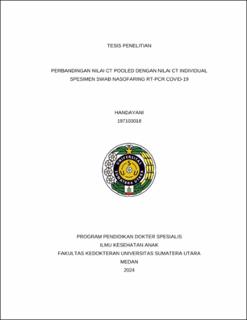Perbandingan Nilai CT Pooled dengan Nilai CT Individual Spesimen Swab Nasofaring RT-PCR Covid-19
Comparison of Cycle Threshold Values Between Individual and Pooled Nasopharyngeal Reverse Transcription-Polymerase Chain Reaction Swab Specimens in Covid-19

Date
2024Author
Handayani, Handayani
Advisor(s)
Lubis, Aridamuriany Dwiputri
Lubis, Inke Nadia Diniyanti
Metadata
Show full item recordAbstract
Background. The molecular reverse transcription-polymerase chain reaction (RT-PCR) testing of respiratory tract swabs has become mandatory to confirm the diagnosis of coronavirus disease 2019 (COVID-19). However, RT-PCR tests are expensive, require standardized equipment, and relatively long testing times and the sample pooling method has been introduced to solve this issue.
Objective. The aim of this study was to compare the cycle threshold (Ct) values of the individual sample and pooled sample methods to assess how accurate the pooling method.
Methods. Repeat RT-PCR examinations were initially performed to confirm the Ct values for each sample before running the pooled test procedure. Sample extraction and amplification were performed in both assays to detect ORF1ab, N, and E genes with a cut-off point value of Ct <38.
Results. Overall, there was no difference in Ct values between individual sample groups and pooled sample groups at all concentrations (p=0.259) and for all pooled sizes. Only pooled size of five could detect the Ct value in the pooled samples for all concentration samples including low-concentration sample (Ct values 36 to 38).
Conclusion. This study highlighted that pooled RT-PCR testing strategy did not reduce the quality of individually measured RT-PCR Ct values. A pool size of five could provide a practical technique to expand the screening capacity of RT-PCR.
Collections
- Master Theses [362]
